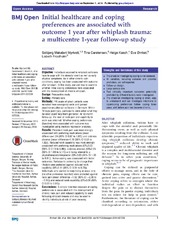| dc.contributor.author | Myrtveit, Solbjørg Makalani | en_US |
| dc.contributor.author | Carstensen, Tina | en_US |
| dc.contributor.author | Kasch, Helge | en_US |
| dc.contributor.author | Ørnbøl, Eva | en_US |
| dc.contributor.author | Frostholm, Lisbeth | en_US |
| dc.date.accessioned | 2015-09-02T07:45:43Z | |
| dc.date.available | 2015-09-02T07:45:43Z | |
| dc.date.issued | 2015-03-20 | |
| dc.Published | BMJ Open 2015, 5:e007239(3) | eng |
| dc.identifier.issn | 2044-6055 | |
| dc.identifier.uri | https://hdl.handle.net/1956/10374 | |
| dc.description.abstract | Objective: Individuals exposed to whiplash collisions have to cope with the stressful event as well as early physical symptoms. As in other chronic pain conditions, coping has been associated with outcome after whiplash. In this study, our aim was to examine whether initial coping preferences were associated with the development of chronic whiplash. Design: Prospective study. Setting: Primary care. Methods: 740 acute whiplash patients were recruited from emergency units and general practitioners after car collisions in Denmark. Within 10 days postinjury, participants were asked what they believed could help them get better. At 12-month follow-up, the level of neck pain and capability to work was obtained. Whether coping preferences (baseline) were associated with outcome was investigated using multiple regression analyses. Results: Persistent neck pain was most strongly associated with preferring medications (mean difference=1.24 (95% CI 0.67 to 1.82)) and sickness absence (mean difference=1.18 (95% CI 0.53 to 1.82)). Reduced work capability was most strongly associated with preferring medications (OR=3.53 (95% CI 2.13 to 5.86)), sickness absence (OR=3.05 (95% CI 1.80 to 5.17)) and being referred to a physiotherapist/chiropractor (OR=3.03 (95% CI 1.33 to 6.91)). Active coping was associated with better outcomes: Participants preferring to change their lifestyle were protected against reduced work capability (OR=0.11 (95% CI 0.01 to 0.78)). Individuals who wanted to keep living as usual only (no other preference reported) were protected against neck pain (mean difference −1.62 (95% CI −2.39 to −0.84)) and reduced work capability (OR=0.09 (95% CI 0.01 to 0.64)). Conclusions: A simple nine-item measure of coping preferences is associated with the development of chronic neck pain and reduced capability to work following whiplash trauma and may be used to identify individuals at risk of poor recovery. | en_US |
| dc.language.iso | eng | eng |
| dc.publisher | BMJ Publishing Group | eng |
| dc.relation.ispartof | <a href="http://hdl.handle.net/1956/10375" target="blank">Risk factors for development and maintenance of chronic whiplash</a> | |
| dc.rights | Attribution CC BY-NC | eng |
| dc.rights.uri | http://creativecommons.org/licenses/by-nc/4.0/ | eng |
| dc.title | Initial healthcare and coping preferences are associated with outcome 1 year after whiplash trauma: A multicentre 1-year follow-up study | en_US |
| dc.type | Peer reviewed | |
| dc.type | Journal article | |
| dc.date.updated | 2015-09-02T07:25:56Z | |
| dc.description.version | publishedVersion | en_US |
| dc.rights.holder | Copyright 2015, British Medical Journal Publishing Group | |
| dc.source.articlenumber | e007239 | |
| dc.identifier.doi | https://doi.org/10.1136/bmjopen-2014-007239 | |
| dc.source.journal | BMJ Open | |
| dc.source.40 | 5 | |
| dc.source.14 | 3 | |

